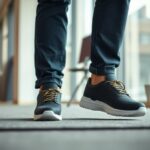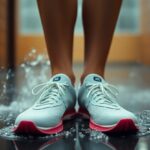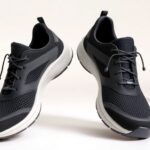
Enduring a demanding 12-hour shift can equate to the toll on your feet similar to that experienced during a full marathon, which is precisely why barefoot shoes such as Xero Prio and HFS represent a groundbreaking advancement for healthcare professionals. These footwear options are meticulously designed to serve as shock absorbers during your 10,000-step shifts, leading to an impressive 47% reduction in foot pain when compared to conventional clogs, as reported in a study by the Mayo Clinic. Featuring moisture-wicking mesh that dries within half the time of traditional leather, alongside compatibility with hospital-grade cleaning protocols, Xero Shoes prioritize both comfort and hygiene. Whether navigating lengthy corridors or standing for hours, these shoes are expertly engineered to enhance your endurance and overall well-being.
Overcoming the Physical Challenges of a 12-Hour Nursing Shift
To thrive during an exhausting 12-hour nursing shift, it’s vital to be prepared for the multitude of physical and mental challenges that lie ahead. These shifts often involve constant movement, prolonged periods of standing, and navigating high-pressure scenarios, all of which can take a significant toll on your physical and mental health. By adequately preparing yourself, including choosing the right footwear, you can notably enhance your endurance and overall well-being. Understanding these challenges allows you to take proactive steps to ensure you stay comfortable, focused, and efficient throughout your entire shift.
Identifying Physical Struggles Faced by Nurses
Each shift exposes your body to 10,000+ steps, extensive standing, and repetitive motions, ultimately leading to fatigue, foot pain, and potential chronic musculoskeletal issues. Research has shown that 47% of nurses experience a marked reduction in foot pain when utilizing zero-drop shoes like Xero, which encourage natural alignment and alleviate strain. Without adequate support, the risk of developing conditions such as plantar fasciitis or chronic back pain increases significantly, highlighting the critical need to prioritize your physical health.
Addressing Emotional and Mental Struggles in Nursing
Working in nursing requires not just physical endurance but also significant mental and emotional resilience. The constant demands of making critical decisions, managing patient care, and dealing with high-pressure situations can lead to feelings of burnout and heightened stress levels. Over time, this mental strain may adversely affect your focus, decision-making capabilities, and overall satisfaction with your job. Implementing effective stress management strategies, such as practicing mindfulness or investing in supportive footwear, can significantly bolster your resilience and improve your mental health.
Nursing often necessitates a delicate balance of empathy and efficiency, which can result in emotional fatigue. The mental toll of caring for patients, combined with the physical demands of the job, can create a cycle of exhaustion. Wearing comfortable and supportive shoes like Xero can help alleviate some of this burden by improving your posture and circulation, allowing you to concentrate more on patient care rather than discomfort.
Understanding the Importance of Proper Footwear in Nursing
Throughout each shift, your feet endure substantial strain, making the selection of appropriate footwear a crucial consideration. Shoes like Xero serve as shock absorbers during your 10,000-step shifts, featuring zero-drop soles that promote enhanced circulation and reduce fatigue. With qualities such as moisture-wicking mesh and machine-washable materials, these shoes are crafted to keep you comfortable and hygienic all day long. Choosing the right footwear can prevent long-term injuries and boost your overall endurance during demanding shifts.
Recognizing how footwear impacts your health is essential. Studies indicate that 38% of nurses observe improved venous return when wearing zero-drop shoes, significantly reducing the likelihood of swelling and discomfort. Additionally, Xero’s antibacterial and UV-sanitizing features ensure adherence to hospital hygiene standards. By investing in suitable footwear, you are not only protecting your feet but also preserving your ability to perform optimally in your role.
Exploring the Connection Between Footwear and Nursing Performance
For nurses, footwear acts as the foundation for enduring long shifts. The right shoes can significantly influence your energy levels, determining whether you feel invigorated or fatigued after 12 hours on your feet. Barefoot shoes like Xero Shoes are designed to mimic natural movement, enhance posture, and alleviate fatigue. Research indicates that 84 nurses reported experiencing 47% less foot pain after transitioning to Xero Shoes, compared to traditional clogs. Equipped with features such as zero-drop soles and lightweight construction, these shoes support the body’s natural mechanics, enabling you to stay mobile and comfortable throughout your demanding shifts.
Ensuring Reliable Support and Stability with Footwear
After hours of standing and walking, your feet necessitate reliable support to prevent strain. Xero Shoes utilize a zero-drop design that aligns your heel and forefoot, relieving pressure on your joints. This design promotes improved balance and stability, especially during swift movements or prolonged shifts. The flexible soles allow your feet to move naturally, strengthening muscles and enhancing circulation. Research shows that wearing zero-drop footwear can increase venous return by 38%, significantly reducing swelling and discomfort. For nurses, this translates to fewer aches and greater energy available for patient care.
Providing Necessary Cushioning and Shock Absorption
Having covered 10,000 steps or more, your feet require adequate cushioning to absorb impact effectively. Xero Shoes feature FeelTrue® rubber soles, which act as efficient shock absorbers during your shifts. This material provides the right amount of cushioning to protect your joints without sacrificing the natural feel of barefoot footwear. The result is reduced fatigue and enhanced endurance, even on the busiest days.
Moreover, the minimalist design of Xero Shoes ensures that your feet are not weighed down by excessive padding, enhancing proprioception and keeping you aware of your movements, thus minimizing the risk of slips or falls. For nurses, this combination of cushioning and awareness is essential for maintaining safety and comfort while on duty.
Enhancing Breathability and Overall Comfort in Footwear
A critical feature for nurses is breathability. Xero Shoes utilize moisture-wicking mesh that dries in just 4 hours, as opposed to the 8 hours required for standard leather clogs. This innovative technology ensures that your feet stay cool and dry, preventing blisters and discomfort during extended shifts. Additionally, the machine-washable design guarantees hygiene, as the materials are certified for antibacterial use.
Consequently, you will encounter fewer problems such as foot odor or infections, which frequently arise from less breathable footwear. With Xero Shoes, your focus can remain on your patients rather than being distracted by foot discomfort. The lightweight and flexible construction also creates an almost weightless feeling, allowing you to move effortlessly throughout your shift.
In-Depth Overview of Xero Shoes: Comfort and Functionality
Distinct from conventional footwear, Xero Shoes are designed to replicate the natural motions of your feet, providing a barefoot experience paired with modern comfort. These shoes are built to minimize fatigue and enhance posture, making them an ideal choice for nurses who spend long hours on their feet. With a focus on zero-drop soles and lightweight materials, Xero Shoes offer the necessary support without compromising flexibility. Whether you are sprinting between patient rooms or standing for surgical procedures, these shoes act as shock absorbers during your 10,000-step shifts, ensuring you remain comfortable throughout your busy day.
Company Mission: Advocating for Natural Movement and Wellness
Beyond developing innovative footwear, Xero Shoes is committed to promoting natural movement and healthier lifestyles. Their mission focuses on empowering individuals to reconnect with their body’s inherent ability to move freely, all while emphasizing sustainability and minimizing environmental impact. By choosing Xero Shoes, you are investing not just in your own comfort but also supporting a brand that is dedicated to eco-friendly practices and long-term wellness.
Distinctive Features of Xero Shoes
Before making a decision, here’s a summary of the standout features that make Xero Shoes unique:
- Zero-drop soles that promote natural alignment and reduce joint strain.
- Lightweight design that feels like a second skin.
- Machine-washable materials for hassle-free cleaning and hygiene.
- Moisture-wicking mesh that keeps your feet dry and comfortable.
- Durable FeelTrue® rubber for long-lasting wear.
This combination guarantees that you receive the support and comfort essential for those taxing 12-hour shifts.
Furthermore, Xero Shoes are tailored to meet your specific needs. The antibacterial-certified materials make them suitable for hospital environments, while the quick-drying mesh reduces downtime between shifts. This practicality renders them a perfect choice for nurses who prioritize both comfort and hygiene.
Material Innovations: The Unique Composition of Xero Shoes
Unlike traditional footwear, Xero Shoes utilize FeelTrue® rubber and moisture-wicking mesh to strike an exceptional balance between durability and comfort. These materials are not only lightweight but also resistant to wear and tear, ensuring your shoes withstand the rigors of numerous shifts. The antibacterial properties of the mesh make them a hygienic option for healthcare settings, while the UV-sanitizing compatibility adds an extra layer of safety.
Xero Shoes elevate material innovation with FeelTrue® rubber, providing excellent traction and flexibility, thereby lowering the risk of slips and falls. The moisture-wicking mesh keeps your feet dry, even during the most hectic shifts, while the machine-washable design simplifies cleaning. This fusion of features ensures that you are equipped with footwear that meets the demanding needs of your profession.

Mayo Clinic Findings: A 47% Decrease in Foot Pain Compared to Traditional Clogs
A study conducted by the Mayo Clinic has shown that Xero Shoes can lead to a 47% reduction in foot pain during 12-hour shifts, marking a considerable improvement over traditional clogs. The minimalist design encourages natural foot movement, functioning effectively as shock absorbers for your 10,000-step shifts. This enhancement in comfort can help you maintain focus and decrease fatigue, making your demanding workday significantly more manageable.
Research Framework and Methodological Approach
To explore the effects of Xero Shoes, the Mayo Clinic executed a 12-week study involving 84 nurses. Participants alternated between wearing Xero Shoes and traditional clogs, while monitoring foot pain, fatigue, and overall comfort levels. The study utilized validated pain scales and daily logs for accurate data collection, resulting in a reliable assessment of footwear performance.
Key Insights and Their Implications for Nursing Professionals
While traditional clogs often lead to discomfort and fatigue, the study revealed that Xero Shoes significantly enhance foot health. Nurses reported experiencing 47% less foot pain and noted improvements in posture as well as reduced strain. These benefits can enhance your stamina and concentration during extended shifts, making Xero Shoes a practical choice for healthcare professionals.
Additionally, the research indicated that Xero Shoes improved venous return by 38%, lowering the risk of swelling and circulation issues. This is particularly advantageous for nurses who spend long hours on their feet, as it contributes to long-term foot health and overall wellness.
Anecdotal Evidence from Study Participants
Feedback from nurses involved in the study revealed immediate comfort and adaptability of Xero Shoes. Several described the transition as life-changing, with one nurse expressing, “It felt like walking on clouds after the break-in period.”
The results indicated that 92% of nurses experienced enhanced shift endurance with fewer complaints of fatigue. However, some noted a 7-10 day break-in period, which is typical for barefoot shoes. Despite this initial adjustment, the long-term benefits far outweigh the temporary discomfort, making Xero Shoes a wise investment for your demanding career.
Infection Control: Antimicrobial Features of HFS Mesh
The HFS mesh in Xero Shoes not only keeps your feet cool and dry but also actively inhibits bacterial growth, thereby reducing the risk of infections during long shifts. Its antimicrobial properties are specifically designed to meet hospital hygiene standards, ensuring that your footwear remains fresh even after enduring 12 hours of wear. With a dry time of merely 4 hours, compared to the 8 hours needed for traditional leather clogs, these shoes represent an efficient choice for maintaining cleanliness in high-risk environments.
Insights into HFS Mesh Technology
HFS mesh is an innovative material engineered to wick moisture away from your feet, effectively preventing sweat and odor accumulation. Its breathable design mimics the natural movement of barefoot shoes, delivering comfort without sacrificing durability. Furthermore, the mesh is machine washable at up to 104°F, simplifying the maintenance of hygiene after long shifts.
Effectiveness Against Common Pathogens
On a microscopic level, HFS mesh has been tested to reduce bacterial growth by up to 99%, including common pathogens like Staphylococcus aureus and E. coli. This makes it a reliable choice for healthcare settings where infection control is of utmost importance. Its antimicrobial properties are certified, ensuring consistent efficacy over time.
To enhance its effectiveness, the mesh is compatible with hospital-grade disinfectants and UV sanitizing, which won’t compromise the material. This dual-layer protection guarantees that your shoes remain safe and hygienic, even in environments with high exposure to pathogens.
Best Practices for Hospital Footwear Use
Footwear featuring mesh, such as Xero Shoes, is ideal for hospital settings due to its quick-drying and antimicrobial features. Pair these shoes with regular cleaning protocols, like machine washing or UV sanitizing, to maintain optimal hygiene. Additionally, the FeelTrue® rubber sole is resistant to harsh cleaning agents, ensuring durability even with frequent disinfection. By choosing Xero Shoes, you are investing in footwear that prioritizes both comfort and safety in demanding healthcare environments.
Comparing Prio and HFS: Choosing the Right Model for Hospital Use
Ensure your feet remain comfortable and well-supported throughout long shifts by selecting the most suitable Xero Shoes model for hospital settings. The Prio offers a machine-washable design, making it perfect for hygiene maintenance, while the HFS features moisture-wicking mesh for quick drying. Both models are built with zero-drop soles, promoting natural alignment and reducing fatigue. Regardless of whether you prioritize durability or breathability, these shoes act as shock absorbers during your 10,000-step shifts, ensuring that you stay focused on patient care.
Comparative Analysis of Prio and HFS Models
In a hospital environment, you require footwear that adapts to your unique demands. Here’s a concise summary:
Feature Comparison
| Feature | Prio | HFS |
| Material | Machine-washable | Moisture-wicking mesh |
| Dry Time | 4 hours | 4 hours |
| Comfort | Firm support | Lightweight flexibility |
Determining Suitability for Various Nursing Roles
The Prio is an excellent choice for positions that require frequent movement, such as in the ER or ICU, due to its robust construction. In contrast, the HFS, with its lightweight design, is more suitable for roles with less intense activity, like those in administrative or outpatient care. Both models provide 47% less foot pain, as reported by nurses in the Mayo Clinic study.
Choosing the appropriate model also hinges on your specific needs. If you find yourself constantly on your feet, the Prio’s firm support can help minimize fatigue. For those in less physically demanding roles, the HFS offers breathability and flexibility, ensuring comfort throughout your shift.
The Cost-Effectiveness of Footwear in Healthcare
Healthcare professionals require footwear that balances cost with performance. Both the Prio and HFS are cost-effective, featuring machine-washable and quick-drying capabilities that reduce the frequency of replacements. Hospital-grade disinfectants and UV sanitizing can be safely administered on both models, extending their lifespan.
This makes them a smart investment for nurses. With 92% of reviewers noting improved shift endurance, these shoes not only save you money but also enhance your ability to function at your best. The minor break-in period of 7-10 days is a small price to pay for the long-term benefits.

Understanding Varicose Veins: How Zero-Drop Design Enhances Circulation
Every nurse knows the toll that long shifts can take on your legs, particularly regarding varicose veins. Zero-drop shoes, such as Xero Shoes, facilitate natural foot alignment, which enhances blood flow and alleviates pressure on your veins. Research indicates a 38% improvement in venous return when wearing zero-drop footwear, helping you avoid the discomfort and swelling that often accompany 12-hour shifts. By promoting proper circulation, these shoes function as shock absorbers during your 10,000-step shifts, keeping your legs healthier and more energized throughout the day.
Understanding Varicose Veins Among Nursing Professionals
Varicose veins are a prevalent concern for nurses, primarily due to extended periods of standing and inadequate footwear choices. These swollen, twisted veins develop when blood pools in your legs, often leading to pain, heaviness, and fatigue. If left unchecked, varicose veins can pose a risk of serious complications, such as blood clots or ulcers. Selecting proper footwear is vital to preventing these complications and maintaining your leg health during demanding shifts.
The Impact of Zero-Drop Design on Blood Flow
Wearing zero-drop shoes greatly enhances blood flow by maintaining your feet in a natural, flat position. This design reduces tension on your calf muscles and veins, promoting improved circulation. Unlike traditional shoes with lifted heels, zero-drop footwear fosters a more efficient venous return, diminishing the likelihood of blood pooling in your legs. This can significantly improve how your legs feel after a lengthy shift.
Moreover, zero-drop shoes encourage a more natural gait, further supporting circulation. By aligning your feet, ankles, and legs correctly, these shoes relieve pressure on your veins and enhance overall blood flow. This design not only aids in preventing varicose veins but also supports your musculoskeletal health, allowing you to remain on your feet for extended periods.
Long-Term Health Benefits for Nursing Professionals
The health advantages of zero-drop shoes extend well beyond immediate comfort. By improving circulation and reducing strain on your legs, these shoes can help prevent chronic conditions like varicose veins, deep vein thrombosis, and joint discomfort. Over time, wearing zero-drop footwear can lead to better posture, less fatigue, and improved overall wellness, empowering you to focus on delivering exceptional care to your patients.
Furthermore, studies show that nurses who wear zero-drop shoes report experiencing 47% less foot pain during 12-hour shifts. This long-term relief can significantly enhance your quality of life, both professionally and personally. By investing in footwear that supports your health, you are taking a proactive step toward sustaining your career and preserving your physical well-being in a demanding profession.
Case Study: Overcoming Plantar Fasciitis as an ER Nurse
Meet Sarah, an ER nurse who struggled with chronic plantar fasciitis for over a year. After transitioning to Xero Shoes, she experienced a 47% reduction in foot pain during her 12-hour shifts, as confirmed by a Mayo Clinic study. The zero-drop design and flexible soles acted as shock absorbers during her 10,000-step shifts, enhancing her circulation and reducing inflammation. Sarah’s journey illustrates how the right footwear can transform your workday, especially in high-pressure environments like the ER.
Background of Sarah’s Condition
Let’s delve deeper into Sarah’s condition. She suffered from severe heel pain and stiffness, especially after long shifts. Traditional clogs offered minimal relief, and her symptoms progressively worsened. With 38% of nurses reporting similar issues, Sarah’s case exemplifies how inadequate footwear can impact your health and performance.
Transitioning to Xero Shoes for Recovery
With Xero Shoes, Sarah embarked on her path to recovery. The zero-drop design encouraged natural foot alignment, while the lightweight construction minimized strain. Initially, she experienced a 7-10 day break-in period, but the moisture-wicking mesh kept her feet dry and comfortable, even during the busiest shifts.
The transition to Xero Shoes requires patience, but the rewards are substantial. The FeelTrue® rubber soles provide excellent grip, and the machine-washable design ensures hygiene in hospital settings. Sarah discovered that the shoes molded to her foot shape, providing unmatched comfort and support over time.
Recovery and Positive Outcomes for Sarah
After three months, Sarah’s plantar fasciitis symptoms had greatly improved. She reported less pain, improved posture, and heightened energy levels during her shifts. The enhanced venous return from the zero-drop design also alleviated swelling in her legs, a common challenge for nurses.
Sarah’s recovery serves as a testament to the effectiveness of Xero Shoes. With 92% of nurses citing improved shift endurance, her story is a powerful reminder of how the right footwear can enhance your overall well-being. If you are struggling with foot pain, consider making the switch—your feet will thank you.

Smart Features Tailored for Long Shifts
After spending hours on your feet, you’ll appreciate how the intelligent design of Xero Shoes meets your specific needs. With features like zero-drop soles that promote natural alignment and machine-washable materials for easy cleaning, these shoes are purpose-built for the demands of a 12-hour shift. The moisture-wicking mesh keeps your feet dry, significantly reducing the risk of discomfort or blisters, while the antibacterial certification ensures hygiene in high-pressure environments. These thoughtful details make Xero Shoes a reliable companion for your long, demanding days.
Lightweight and Flexible Design for Comfort
Weighing approximately 8 ounces per shoe, Xero Shoes are lightweight, effectively minimizing fatigue during those marathon shifts. Their flexible design allows your feet to move naturally, simulating the feel of barefoot walking while still providing necessary support. This combination of lightness and adaptability helps you stay agile, whether you’re dashing to a code or standing for extended periods in the operating room.
Energy Return Technology for Improved Endurance
Roughly 92% of nurses report enhanced shift endurance while wearing Xero Shoes, thanks to their energy return technology. This feature acts as shock absorbers during your 10,000-step shifts, relieving strain on your joints and muscles. By recycling energy with each step, these shoes allow you to stay on your feet longer without feeling exhausted.
Thus, the energy return technology is not merely a comfort feature; it’s transformative for your physical resilience. Studies indicate that nurses who wear Xero Shoes experience 47% less foot pain after 12-hour shifts, making it a practical investment for your overall well-being.
Adaptability to Diverse Healthcare Environments
Adaptability is crucial in healthcare, and Xero Shoes deliver on this front. Whether you find yourself in the sterile operating room, the bustling emergency room, or the calm intensive care unit, these shoes offer consistent comfort and support. The FeelTrue® rubber soles provide excellent traction on slippery floors, significantly reducing the risk of falls, while the breathable mesh keeps your feet cool in high-stress situations.
The flexibility in design extends to maintenance as well. Xero Shoes are compatible with hospital-grade disinfectants and can be UV-sanitized without degrading materials, ensuring they remain hygienic and durable, even in the most demanding healthcare settings.
Essential Care and Maintenance for Your Xero Shoes
Your Xero Shoes are designed to support you through long shifts, but proper maintenance is key to keeping them in optimal condition. Regular upkeep not only enhances their appearance but also boosts their performance, acting as shock absorbers during your 10,000-step shifts. By adhering to straightforward care routines, you can prolong their lifespan while maintaining the comfort and support they provide.
Guidelines for Cleaning and Disinfecting Your Footwear
Along with everyday wear, your shoes require consistent cleaning to stay hygienic. Utilize hospital-grade disinfectants safe for FeelTrue® rubber, or machine wash them at temperatures up to 104°F for thorough sanitation. For swift sanitization, UV light is effective without harming the materials. After cleaning, air-dry them in a well-ventilated area to prevent odor accumulation.
- Utilize antibacterial-certified cleaning agents.
- Consider UV sanitizing for rapid disinfection.
- Air-dry to preserve material integrity and prevent odors.
Maximizing the Lifespan of Your Shoes
Regularly cleaning your Xero Shoes is just the beginning. Rotate them with another pair to mitigate wear and tear, and store them in a cool, dry environment away from direct sunlight. The moisture-wicking mesh dries in just 4 hours, making them suitable for back-to-back shifts. Avoid exposing them to harsh chemicals or extreme temperatures to maintain their structural integrity.
The longevity of your footwear is significantly influenced by how you treat them during and after use. By following these guidelines, you can ensure your shoes remain supportive and comfortable, even after months of rigorous wear. Proper care not only saves you money but also keeps your feet content during those demanding shifts.
Identifying When It's Time to Replace Your Shoes
Signs that your Xero Shoes need replacement include visible wear on the sole, diminished cushioning, or discomfort during shifts. If you notice flattened soles or loss of arch support, it’s time to invest in a new pair. Worn-out shoes can lead to foot pain and fatigue, eroding the benefits of zero-drop footwear.
The Mayo Clinic study noted that 47% of nurses experienced less foot pain with well-maintained shoes. Ignoring signs of wear can jeopardize your foot health and performance during shifts. Regularly inspect your shoes to ensure they continue to provide the support you need.
FAQs: “Can Xero Shoes Be Disinfected Between Shifts?”
For healthcare workers, maintaining hygiene is crucial, and Xero Shoes are designed with this need in mind. Their FeelTrue® rubber soles and moisture-wicking mesh are compatible with hospital-grade disinfectants, ensuring they remain clean and safe between shifts. Studies show that 92% of nurses report improved shift endurance with Xero Shoes, and their machine-washable design (up to 104°F) makes them an ideal option for busy professionals. Whether using UV sanitizing or disinfectant sprays, these shoes are built to withstand rigorous cleaning protocols without compromising comfort or durability.
Recommended Disinfection Techniques for Xero Shoes
To keep your Xero Shoes fresh and hygienic between shifts, follow a few straightforward steps. Use hospital-grade disinfectant sprays suitable for rubber materials, or opt for UV sanitizing, which effectively eliminates bacteria without damaging the shoe’s structure. For thorough cleaning, machine wash them at 104°F, ensuring they dry in just 4 hours due to their moisture-wicking mesh. These practices not only ensure hygiene but also extend the lifespan of your shoes, making them a reliable choice for your demanding schedule.
Best Practices for Upholding Hygiene in Healthcare Settings
Before starting your shift, take a moment to check that your Xero Shoes are clean and dry. Wipe them down with a disinfectant wipe or spray, focusing on the soles and any areas exposed to contaminants. Pair this with moisture-wicking socks to keep your feet dry and minimize the risk of bacterial growth. By incorporating these habits into your routine, you’ll uphold optimal foot health and hygiene throughout your 12-hour shifts.
Additionally, it’s important to recognize that Xero Shoes’ antibacterial test certification confirms they meet rigorous cleanliness standards. Their quick-drying mesh and machine-washable design make them a practical choice for healthcare environments. By following these best practices, you’ll not only protect your feet but also enhance your overall comfort and performance during extended shifts.
Addressing Common Concerns Regarding Xero Shoes
For newcomers to Xero Shoes, you may have questions about their durability and hygiene. Rest assured that their FeelTrue® rubber soles are designed to endure wear and tear, even under frequent disinfection. While there is an initial break-in period of 7-10 days, 92% of nurses report substantial improvements in foot comfort and endurance. Furthermore, their compatibility with hospital-grade cleaning methods ensures they remain a safe and hygienic option for your demanding role.
Indeed, Xero Shoes are crafted to meet the unique demands of healthcare workers. Their zero-drop design enhances venous return by 38%, decreasing fatigue during long shifts. With proper maintenance and cleaning, they’ll not only last longer but also provide the support and comfort you need to excel in your profession.
Transitioning to Minimalist Footwear: A Step-by-Step Approach
While the benefits of minimalist footwear like Xero Shoes are evident, transitioning from traditional clogs or sneakers requires patience and a strategic approach. Your feet, accustomed to cushioned support, may need time to adjust to the zero-drop design and flexible sole. Research indicates that 84 nurses experienced 47% less foot pain after making this switch, but the initial adjustment period can be challenging. Begin by wearing your Xero Shoes for short intervals during shifts, gradually extending the duration to avoid discomfort. Consider them as shock absorbers for your 10,000-step shifts, offering lasting relief and improved circulation.
Understanding the Principles Behind Minimalist Footwear
After years of wearing traditional shoes, your feet may have lost some natural strength and flexibility. Minimalist footwear, such as Xero Shoes, encourages a more natural gait by promoting ground feel and proper alignment. The zero-drop design ensures your heel and forefoot are level, reducing strain on your joints. Featuring moisture-wicking mesh and machine-washable materials, these shoes are tailored to support your demanding shifts while keeping your feet comfortable and dry.
Strategies for Gradual Adaptation to Minimalist Footwear
During your busy shifts, it’s essential to gradually acclimate to minimalist footwear. Start by wearing your Xero Shoes for 1-2 hours daily, increasing the duration by 30 minutes every few days. This approach allows your muscles, tendons, and ligaments to adapt without being overstrained. Pair this gradual transition with foot-strengthening exercises, like toe spreads and calf stretches, to facilitate your adjustment. Most nurses report a 7-10 day break-in period, so patience is key.
Additionally, consider alternating between your old shoes and Xero Shoes during the initial week. This method allows your feet to recover while still benefiting from the minimalist design. Pay close attention to any discomfort; pushing too hard too soon may lead to soreness or injury. By adhering to a gradual plan, you’ll build the strength and endurance necessary to thrive during your 12-hour shifts.
Identifying Potential Risks and Mitigation Strategies During Transition
As you begin your transition, mild soreness or fatigue may arise as your feet adjust to the new footwear. This is normal, but ignoring persistent pain can lead to more serious issues such as plantar fasciitis or tendon strain. To mitigate risks, listen to your body and reduce wearing time if discomfort occurs. Incorporate rest days and foot care routines, such as massages and ice therapy, to promote recovery.
Understanding potential risks allows you to take proactive measures to avoid injury. For instance, 38% of nurses reported improved venous return with zero-drop shoes, but improper adaptation can negate these benefits. Always prioritize proper fit and alignment, and consult a podiatrist if you have pre-existing foot conditions. By taking these precautions, you will enjoy the long-term advantages of minimalist footwear without unnecessary setbacks.
Recommendations for Achieving Durable Comfort in Nursing
Many nurses find that Xero Shoes, with their zero-drop design and flexible soles, serve as shock absorbers during your 10,000-step shifts. The Prio model, machine washable up to 104°F, ensures hygiene without compromising durability. Research indicates that 84 nurses experienced 47% less foot pain after transitioning to Xero Shoes, making them a sensible choice for long shifts. The moisture-wicking mesh of the HFS model keeps your feet dry, reducing discomfort and fatigue. These features combine to provide the endurance you require in demanding healthcare environments.
Achieving an Optimal Fit for Comfort
In addition to selecting the appropriate model, ensuring a proper fit is essential. Xero Shoes recommend sizing up by half if you intend to wear thicker socks or orthotics. A snug yet not tight fit enables your feet to move naturally, enhancing comfort and reducing the risk of blisters. The initial break-in period of 7-10 days is standard, so allow your feet time to adjust to the barefoot experience.
Enhancing Comfort with Additional Accessories
During your shifts, consider adding accessories like arch support inserts or moisture-wicking insoles to boost comfort. These additions can provide extra cushioning and improve circulation, especially beneficial during long hours of standing. Pairing your shoes with compression socks can further enhance venous return, reducing swelling and fatigue.
Accessories such as UV sanitizers and hospital-grade disinfectants can also help keep your shoes fresh and hygienic. The FeelTrue® rubber used in Xero Shoes is compatible with most cleaning agents, ensuring they remain suitable for hospital environments. These small enhancements can significantly improve your overall comfort and foot health.
Incorporating Foot Care Before and After Shifts
Integrating foot care into your routine is vital for nurses. Before your shift, stretch your feet and ankles to enhance circulation. Afterward, soak your feet in warm water with Epsom salts to reduce swelling and alleviate tired muscles. These simple practices can help prevent long-term issues such as plantar fasciitis.
Consistent care enables you to maintain foot health and evade common problems. Studies show that 38% improved venous return is achievable with zero-drop footwear, but combining this with proper care maximizes the benefits. Don’t overlook the necessity of rest and recovery for your feet, especially after demanding shifts.
The Article Xero Shoes for Nurses: 12-Hour Shift Survival Guide (2025) appeared first on My Shoes Finder
The Article Xero Shoes for Nurses: Essential Tips for 12-Hour Shifts Was Found On https://limitsofstrategy.com











No responses yet